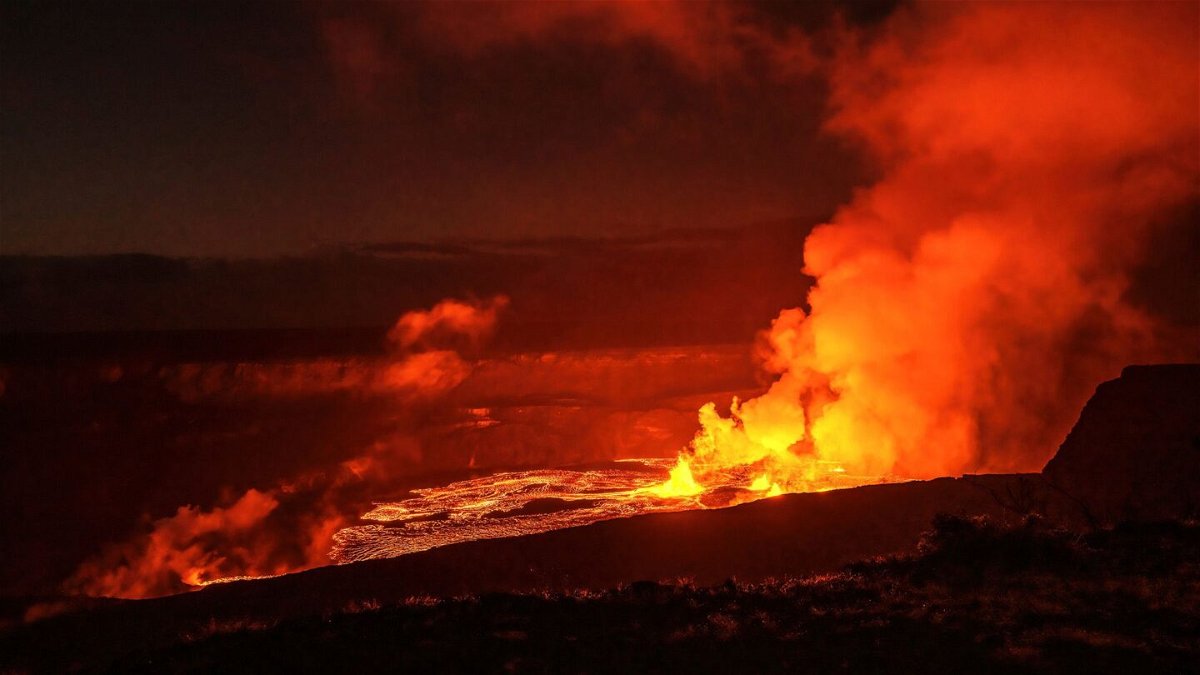Alert level lowered for Hawaii’s erupting Kilauea volcano as thousands watch the dazzling display

By Nouran Salahieh and Paradise Afshar, CNN
(CNN) — US officials lowered the warning level for Hawaii’s erupting Kīlauea volcano on Thursday, saying the burst of lava spewing from within one of its craters has decreased.
The volcano began erupting before sunrise on Wednesday with a burst of lava spewing from within Halemaʻumaʻu crater at Hawai’i Volcanoes National Park – home to two of the world’s most active volcanoes, Kīlauea and Mauna Loa. Officials highlighted a number of safe locations for the thousands who were expected to flock to the area to take in the magnificent view.
Kilauea volcano shot up fountain bursts about 200 feet high during the early phase of the eruption Wednesday, with the largest lava fountain consistently coming in at about 50 feet high, according to the US Geological Survey.
With lava flowing on the surface of the crater floor, the alert level for Kilauea was raised to red for “warning” while authorities evaluated the hazards from the eruption, the Hawaiian Volcano Observatory said Wednesday.
Officials lowered the alert level to “watch” on Thursday, saying the erupting activity is confined to the Halema’uma’u crater. Lava fountain heights have decreased since the eruption began, “likely due to gas loss,” but remain up to about 10 meters (nearly 33 feet) high, the US Geological Survey said in a status update Thursday.
The Hawaiian Volcano Observatory noted that volcanic gas emissions in the area are elevated, and the summit tilt – that is, the slope of the ground due to the amount of magma in the reservoir below the summit – has continued to deflate over the past 24 hours.
Kīlauea’s eruption is confined to the Hawai’i Volcanoes National Park, and officials have said there’s no indication that populated areas are threatened.
The past several summit eruptions at Kilauea have started “vigorously and then decreased over time,” and this latest eruption seems to be following a similar pattern, USGS geologist Katie Mulliken told CNN.
Thousands of people who were expected to visit the national park to see Kīlauea were warned stay on marked trails and overlooks, keep out of closed areas and remember that eruptions are considered a sacred event.
“Witnessing the crust of an active lava lake being dragged into seething fountains is unforgettable,” Hawai’i Volcanoes National Park officials said. “While an eruption is an exciting experience, keep in mind you are observing a sacred event.”
In Native Hawaiian tradition, eruptions have incredible spiritual significance and Kīlauea’s summit is sacred, believed to be the home of Pele the Hawaiian volcano deity, according to the National Park Service.
Those heading out to watch the dazzling lava display in person can watch from as close as half-a-mile away from the Overlook near Keanakākoʻi Crater, a mile away from Uēkahuna and two miles away from Kūpinaʻi Pali from Crater Rim Trail, according to the NPS.
Park officials said lava may be visible from many areas and overlooks surrounding Kaluapele, but warned that conditions can change at any time due to the eruptive activity and weather conditions.
For those who want to take in the spectacle from home, USGS has a livestream of the eruption that shows real-time footage of the lava fountains.
Volcanic gas is the primary concern
High levels of volcanic gas are the primary hazard of concern, the National Park Service said, adding that “this hazard can have far-reaching effects down-wind.”
“Large amounts of volcanic gas—primarily water vapor (H2O), carbon dioxide (CO2), and sulfur dioxide (SO2)—are continuously released during eruptions of Kīlauea volcano,” the NPS said on its website.
Volcanic smog, which has been observed downwind of Kīlauea, creates the potential for airborne health hazards to residents and visitors, the park service added.
Other hazards include long, thin strands of volcanic glass – known as Pele’s hair – and other volcanic fragments from the lava fountains that can fall downwind of the fissure vents, officials added.
The USGS advised residents to minimize exposure to these volcanic particles, which can cause skin and eye irritation.
Kilauea last erupted in January and showed signs of “heightened unrest” in May. The volcano had stopped erupting in December for the first time since September 2021.
The lava from the 2021 eruption was contained to Kilauea’s summit crater, but a previous eruption in 2018 was one of the most destructive in recent Hawaii history, destroying hundreds of homes and forcing evacuations of surrounding neighborhoods.
The-CNN-Wire
™ & © 2023 Cable News Network, Inc., a Warner Bros. Discovery Company. All rights reserved.